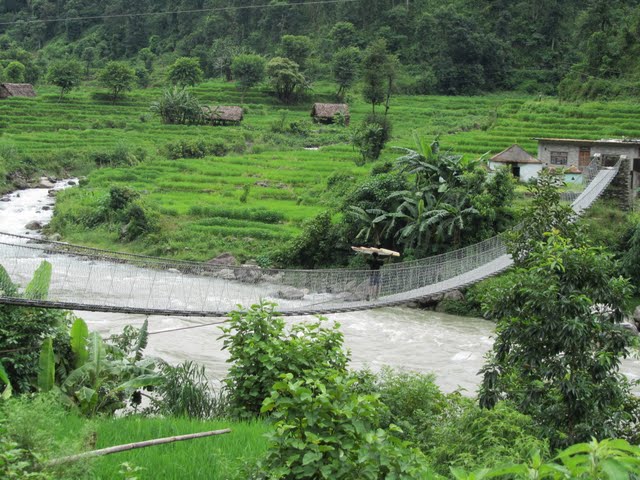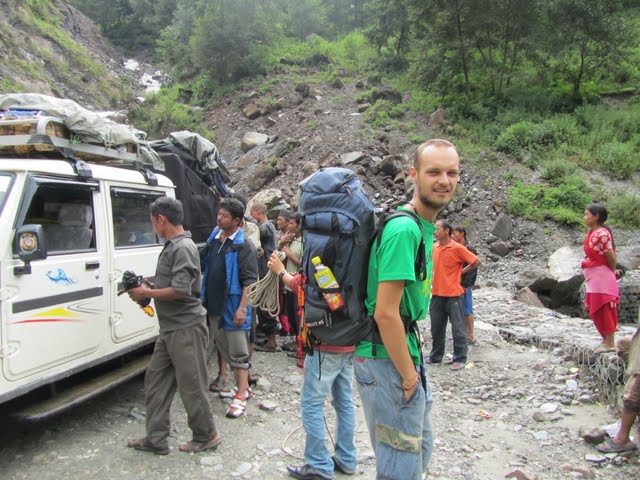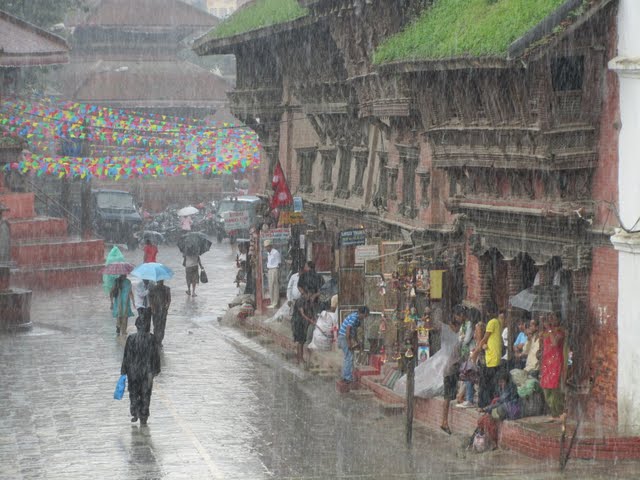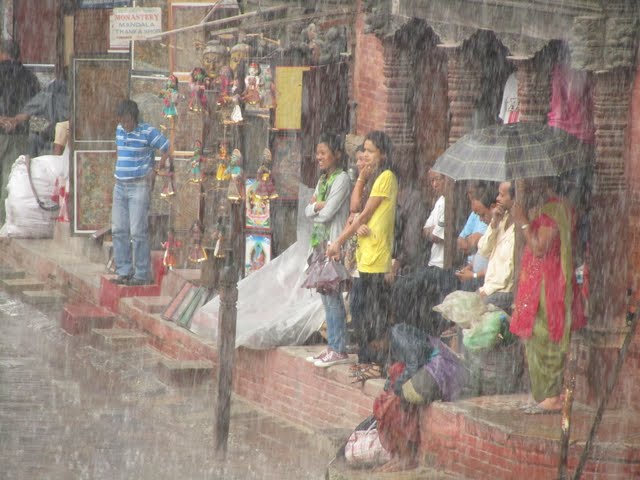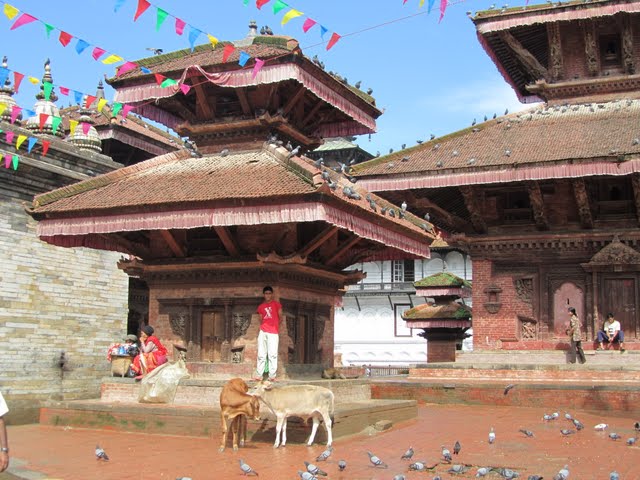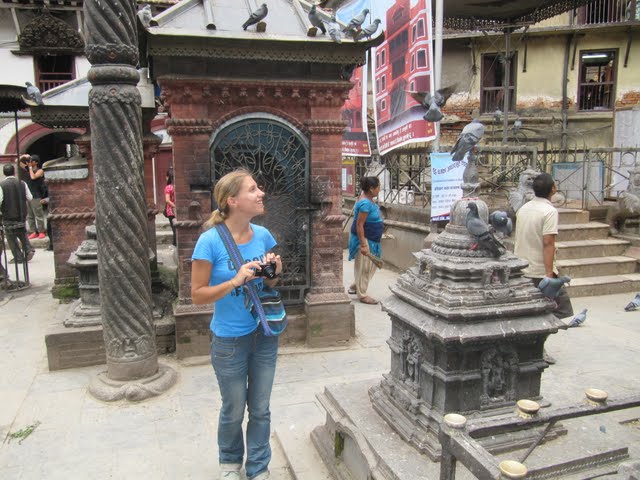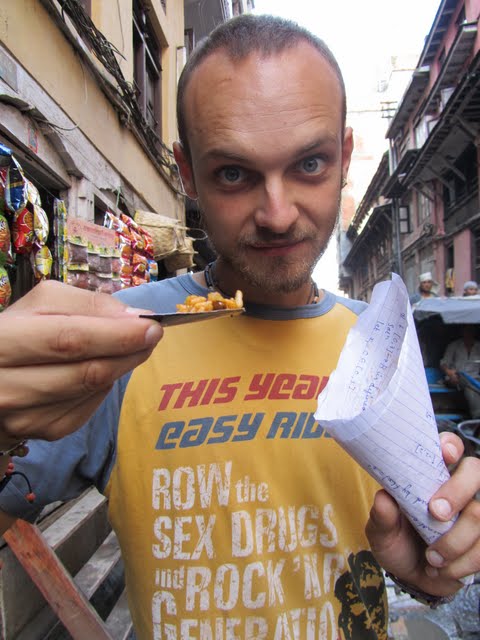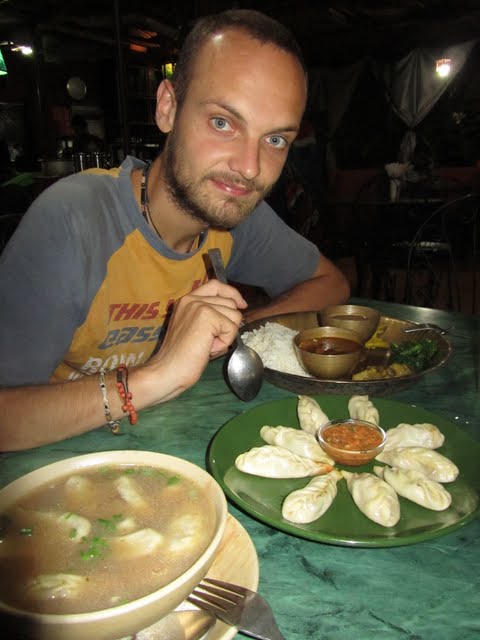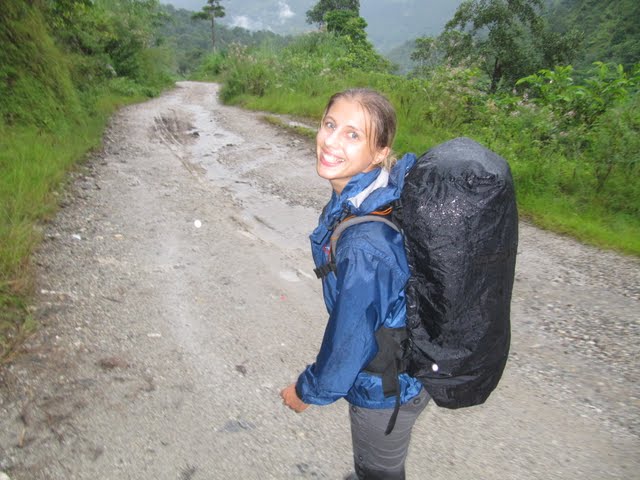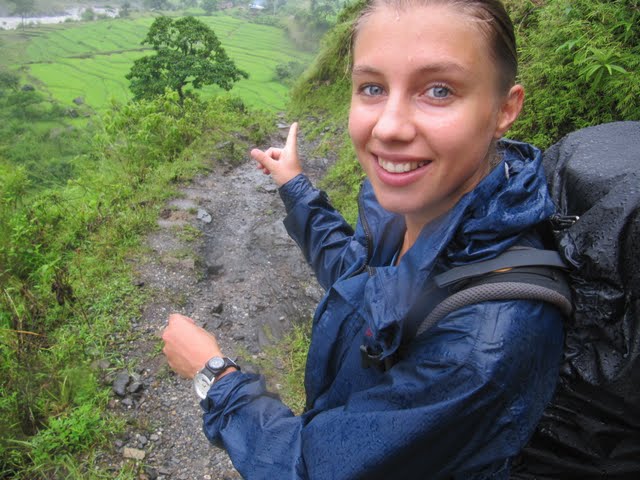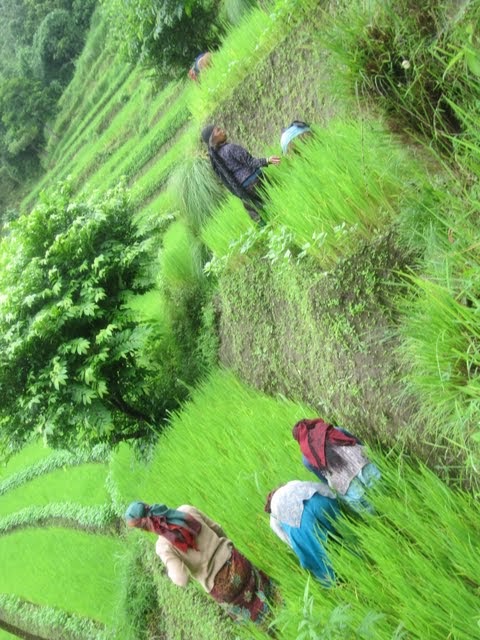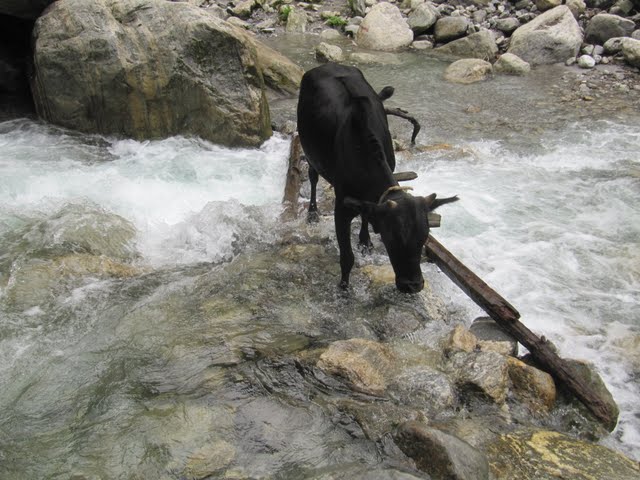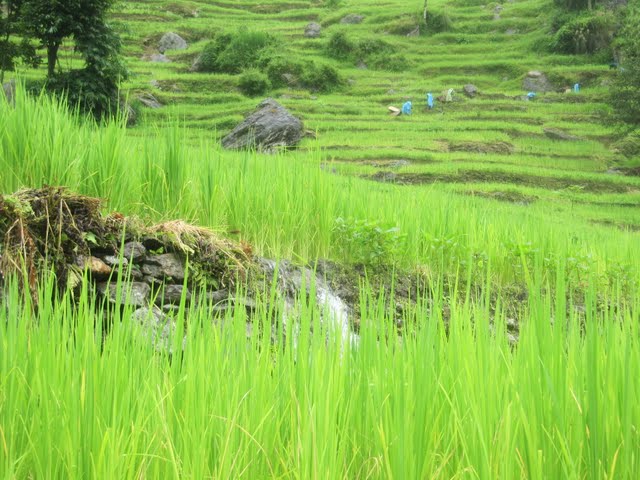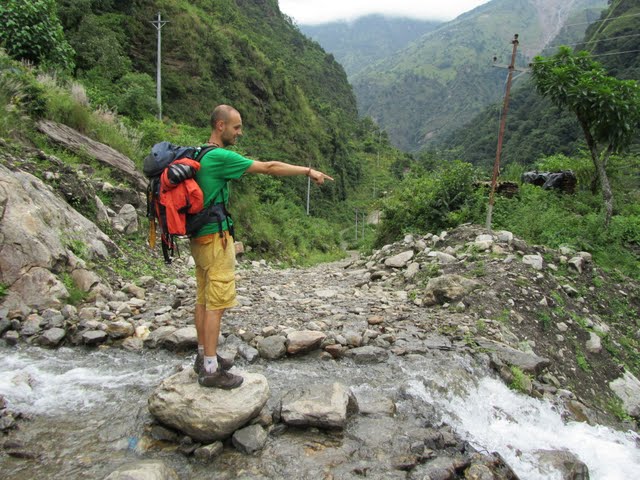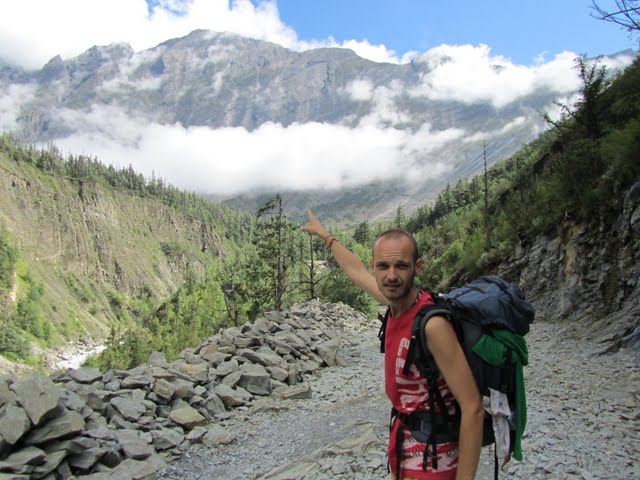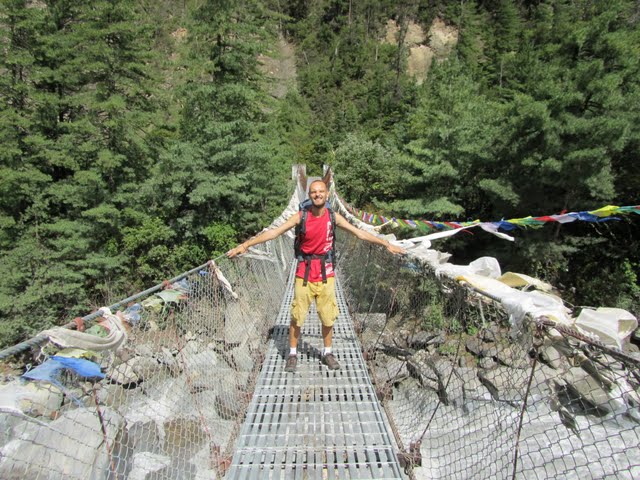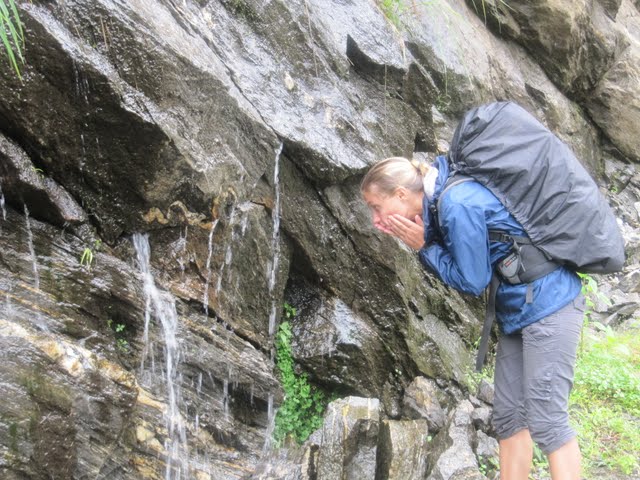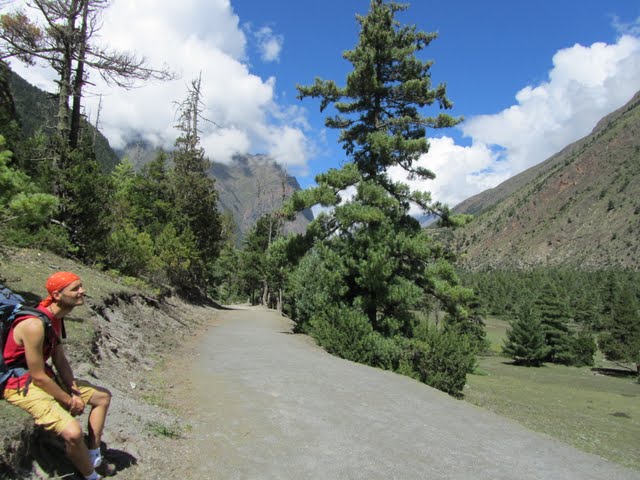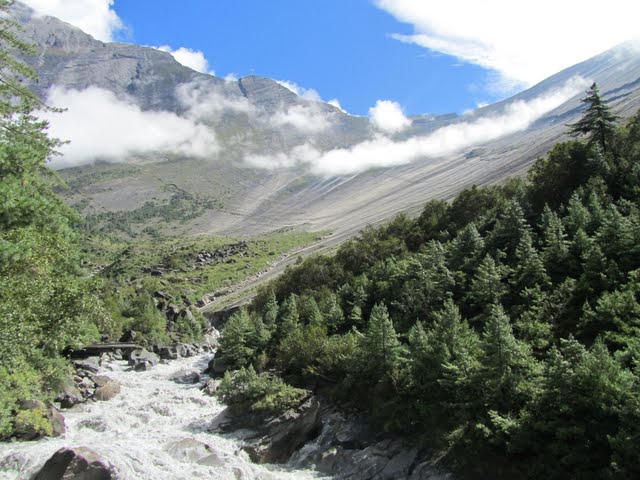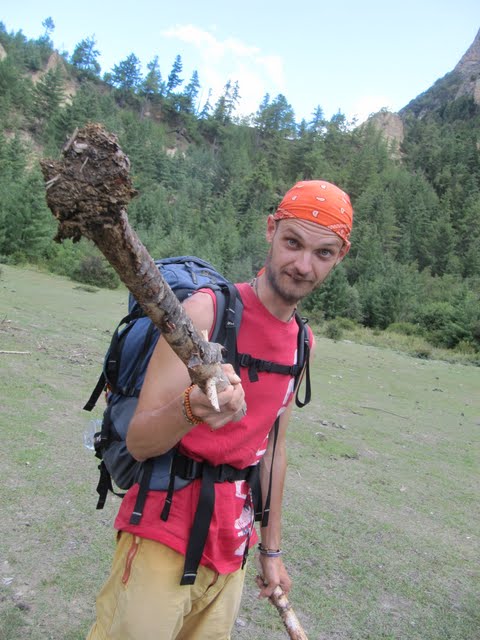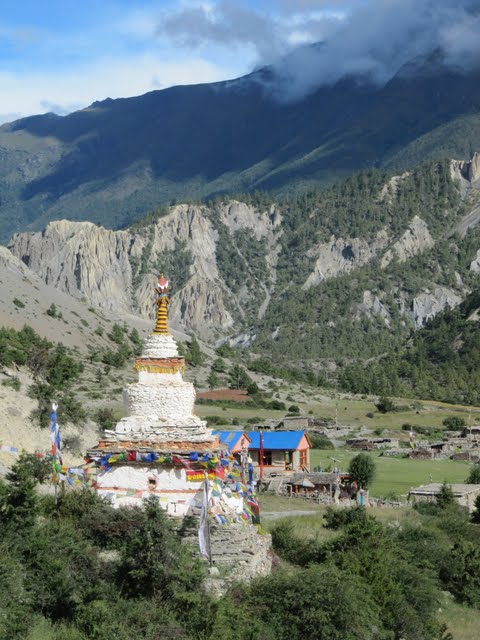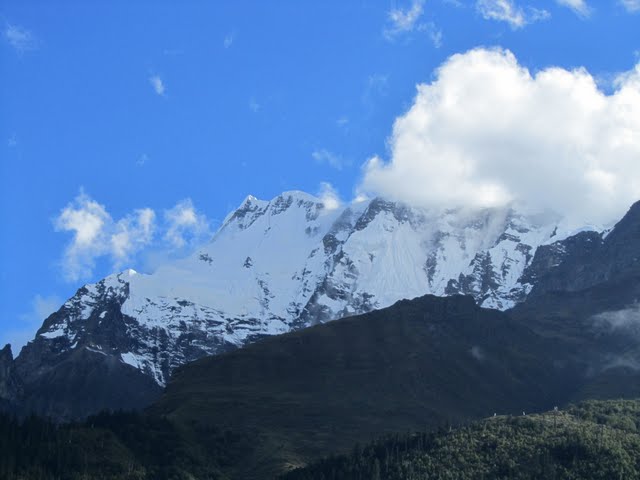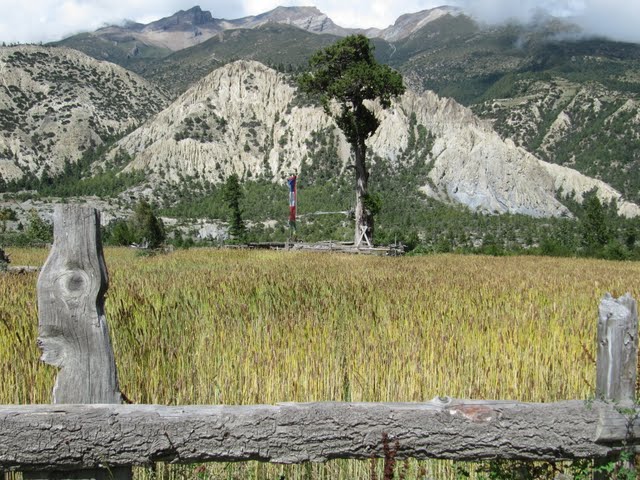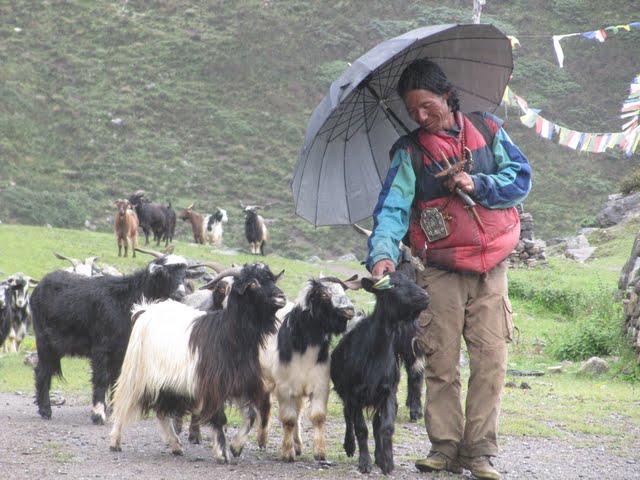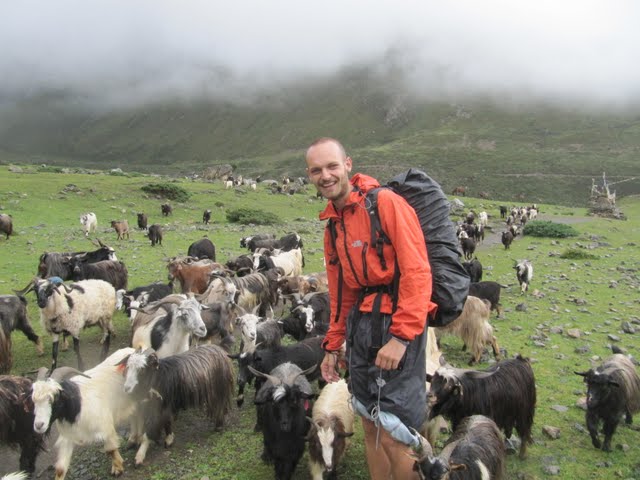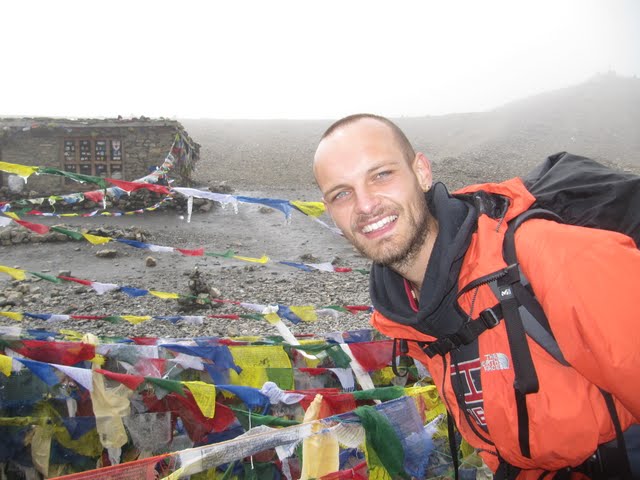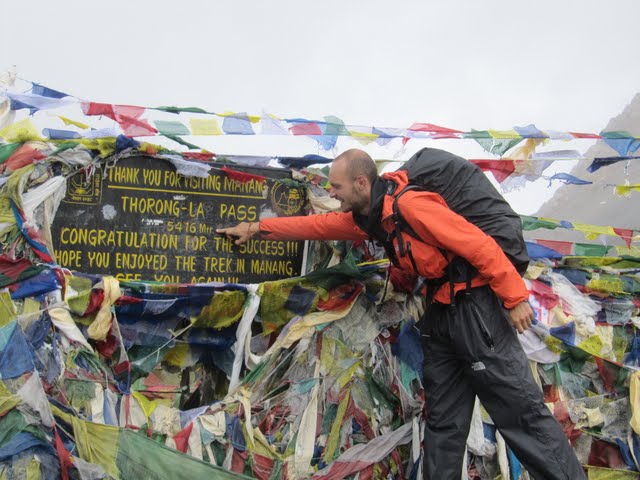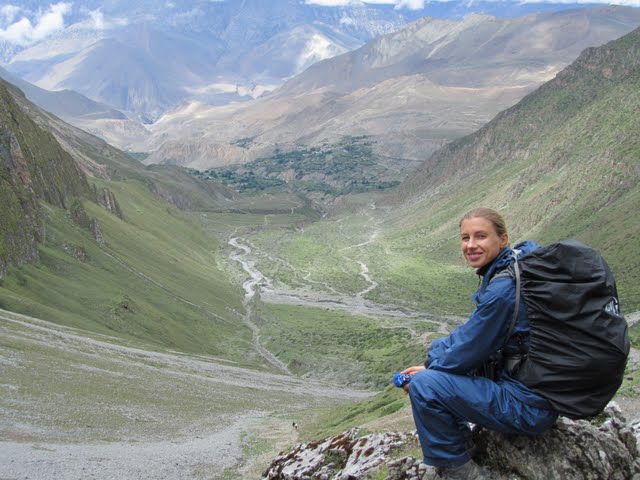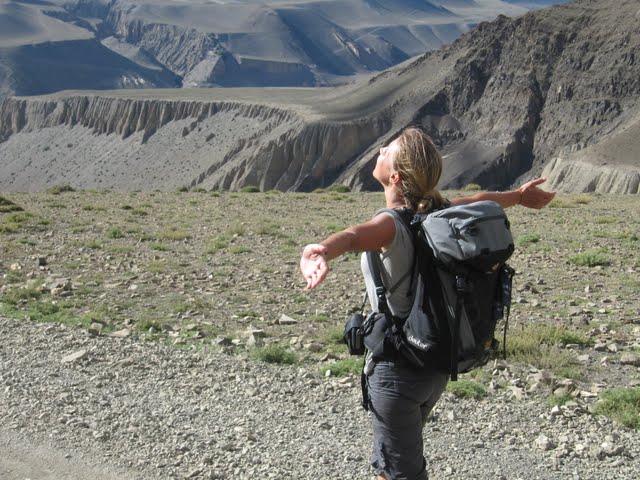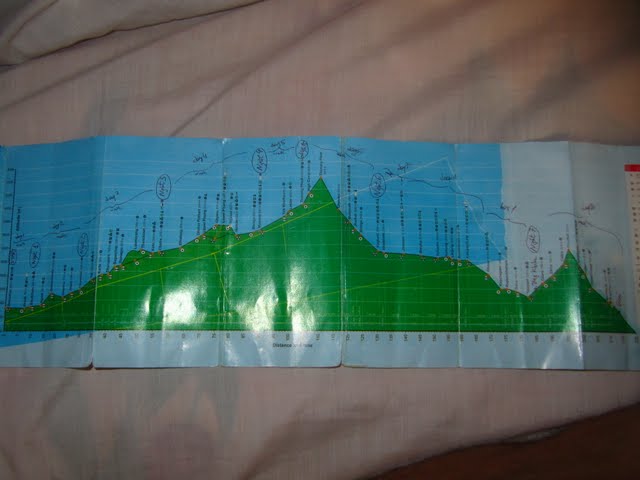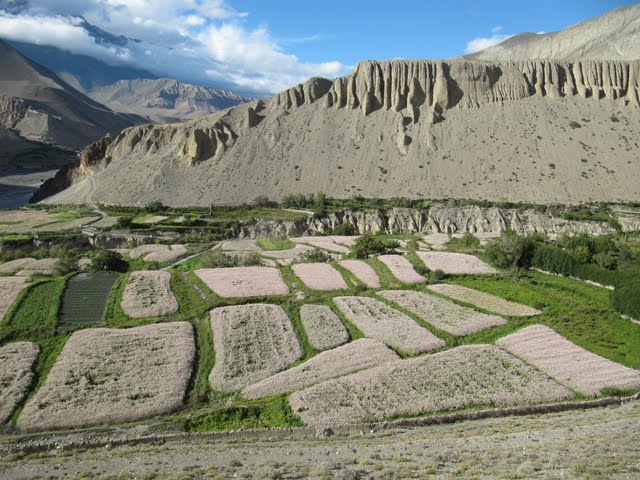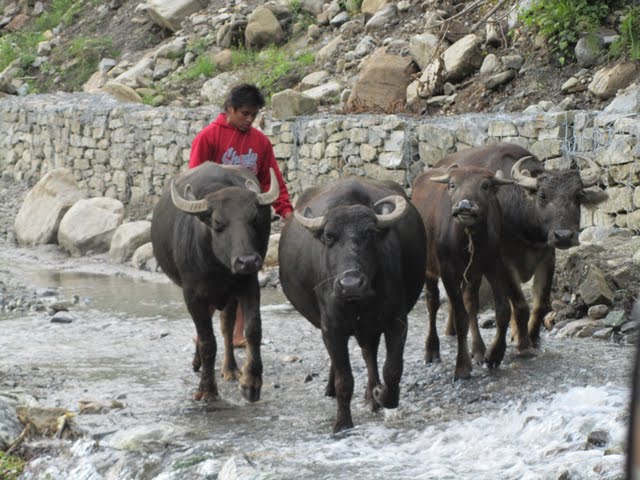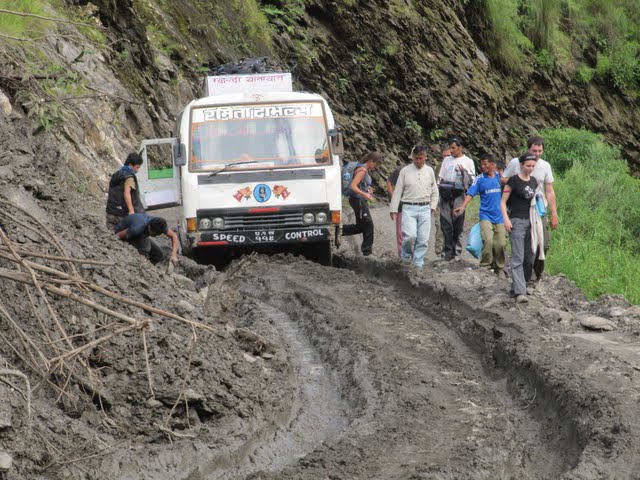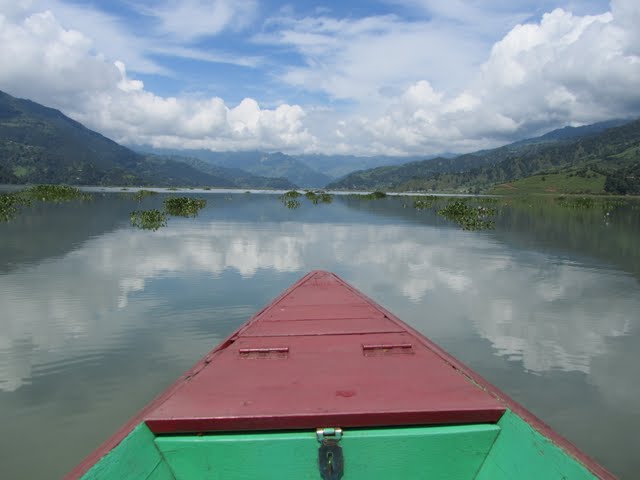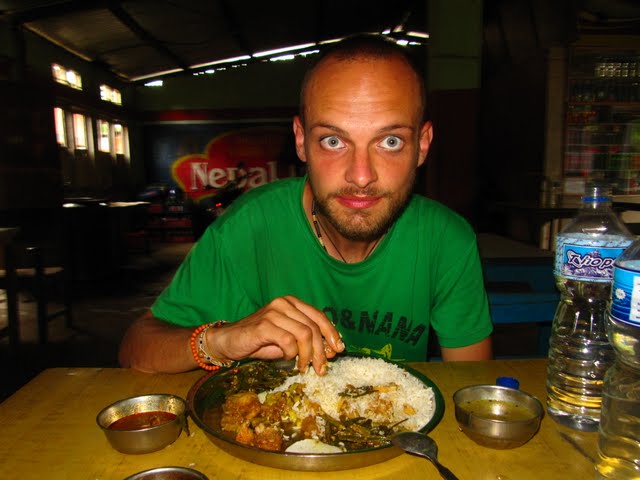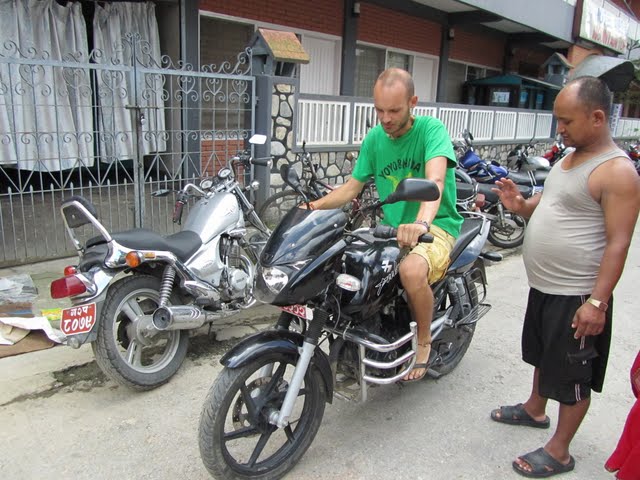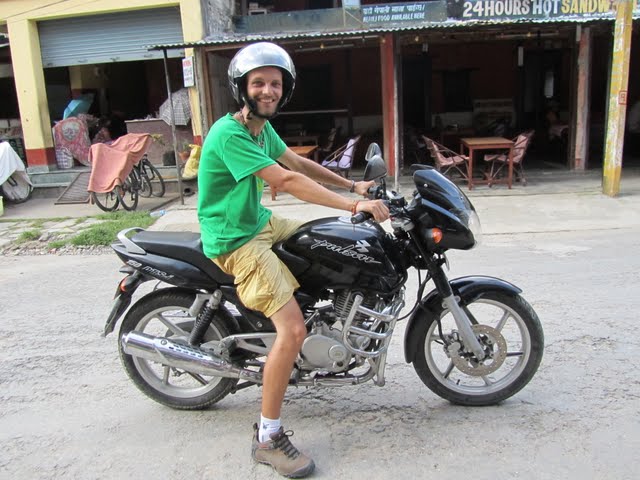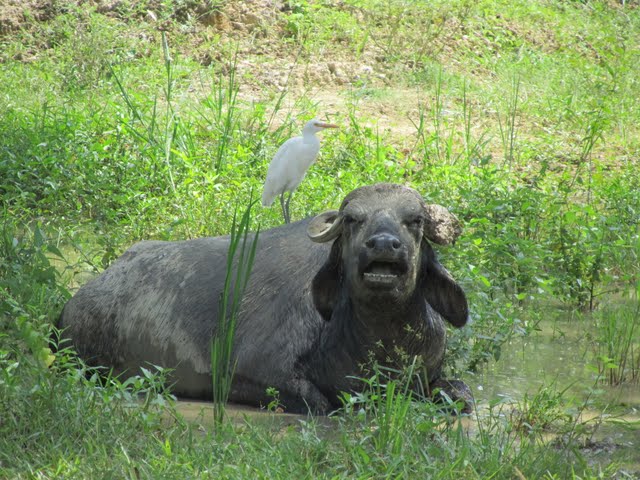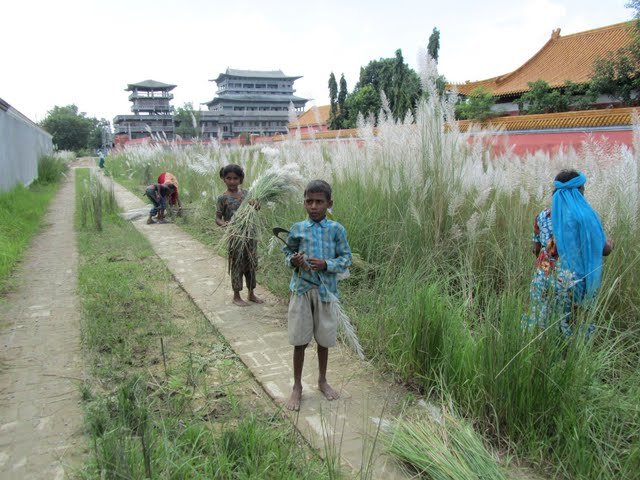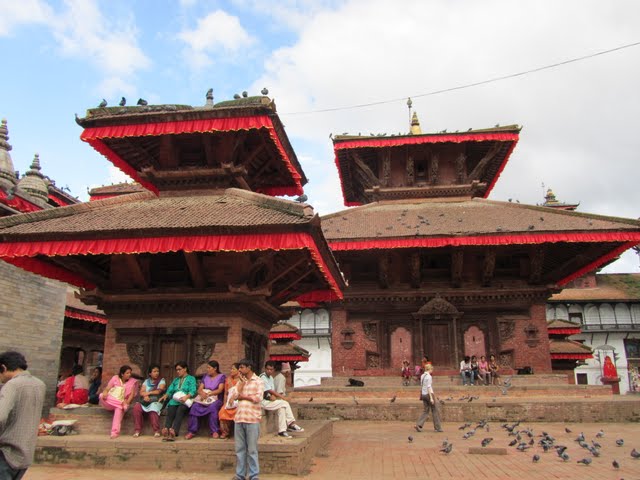Traveling Nepal - in between the giants
Nepal - our first encounter
After our tour through the beautiful high Tibetan plateau, we crossed on foot the Friendship Bridge or what you would call the Tibet-Nepal border. On the one side of that short walk we had strict Chinese customs and serious passport control officials and on the other side the exact opposite of it - a very chaotic quasi-'office' of the Nepali immigration where tourists somehow manage to get separated from the mainstream of Chinese and Nepali people crossing from country to country (they don't need visas for that) and take you to the 'office' so that you can get your entry stamp to Nepal (we already had our Nepali visa acquired in Hong Kong).
Our first impression on Nepali ground was like being in a familiar place again, since everything looked like in India but with a lot of green vegetation and waterfalls everywhere. After some tough bargaining with some jeep drivers, we managed to get to our first landmark before Kathmandu - some point on the road where a major landslide had happened and therefore paralized the through traffic. Over there we had to cross our first (among dozens to follow) waterfall and take another jeep (with the corresponding bargaining again) that took us to Kathmandu. This first landslide seemed to us something isolate, but as we would see afterwards, is synonymous with landslides and definitely the worst and scariest mountain roads in the world.
Kathmandu - the cheerful capital
Kathmandu is a vibrant, beautiful city a bit like most of the Indian cities but much cleaner and actually cozier with tens of temples and pagodas all spread over the city and a very unique architecture.
We spent two days wandering, taking pictures and got the "city card" to be able to walk through the Durbar Square freely (the main square of the city surrounded by temples) and do the fascinating "people-watching" there . During these days we were lucky to be in the city during a festival time due to which Durbar square was flooded with people who were singing and dancing, worshiping and making some offerings in front of the Krishna temple, (it was Krishna festival btw). It looked especially beautiful as all women were wearing red saris, people were selling all kinds of colourful stuff like vegetables, drinks, souvenirs, musical instruments, etc. A very bright day! (they use red and orange paints to decorate their foreheads with a mixture of rice and flowers, and we even saw a local wedding!).
Our next day in Kathmandu was to do some cultural sights at the outskirts of the city, mainly Swayambhunath, or the so-called the Monkey Temple - a great Buddhist stupa with great views over the city. It was here where we finally bought a couple of Tibetan CD's that we were hesitating to buy back in Dharamsala and that we have been hearing from music shops all the way from India. We finally fell for the temptation.
The rest of the day left after walking back to Thamel district (where our guest house was), where you can find all the kind of stuff that backpackers and tourists may need (bookshops, souvenirs, supermarkets, travel agencies, trekking agencies, Internet cafes, bars, restaurants, etc.). It was during this afternoon walk that we started to think about considering of doing a trekking. Kathmandu is full of trekking agencies that try to sell all kinds of trekking, tours, etc., so we tried talking to one of them to see which places he would recommend, which prices, etc. All what we got from that evening was that trekking was too expensive and directions for a local Nepali restaurant where we had dinner that day, which turned out to be Olga's favorite restaurant and as she says "it is the best restaurant in the world!" (Well, with all justice it is a very good restaurant indeed and extremely cheap, and we have been having dinner there every day we have been in Kathmandu!). We are gonna miss it!
Annapurna Circuit - the trek of a lifetime!
After doing some reading from the LP and doing some research on the Internet, we considered ourselves experienced enough and decided to do a trekking around the Annapurna range on our own, without guides or porters. We picked the Annapurna Circuit, labeled as one of the world's classic treks. It is a 12 to 16-day trek that starts in one of the beautiful valleys at about 840 m and goes all the way up through villages and gorges to 5400 m (the highest point of the trek), passing through all kinds of landscapes and vegetation changes.
The good thing of this trek is that accommodation and food is available in all these villages, so the day before leaving we got our trekking permits (there are check points all along the way where you have to register all you data and show all the documents), packed only the necessary clothes to survive for 2 weeks, bought some food like dry fruit and muesli bars and got some fake rainproof light "The North Face" jackets and pants (that is the only trekking kind of clothes you can get from any of the hundreds of shops in Kathmandu) and off we went!
Day 1, Kathmandu to Bhulbhule, the drive, then very relaxed 3 hours walking and a very tough river stretch to cross
The first day was a long bus drive out of the Kathmandu valley through unforgettably bad Nepali roads to Besi Sahar. From there we had a 3-hour walk to Bhulbhule (starting point of the trekking) or a 45 min bus ride to the same village. At first, we thought that after the 8 hours from Kathmandu we were not in the mood to walk yet, so we took the bus. That was a big mistake due to the more than awful state of the muddy road. After 15 minutes of feeling like being a pendulum, going from side to side in a bus and knowing the "tourist price" that the conductor was trying to charge us for the small ride, we decided to step off and walk the rest under the rain. After arguing for some time with the dishonest drivers trying to charge us 10 times more than the locals, we put our rain clothes and walked all the way to Bhulbhule. That was not an easy hike, since we had to put off our shoes several times to cross rivers that grew due to the monsoon season. One was so big and tumultuous that we had to rely on the guidance of local kids to cross it and in the meantime we saw a bus basically swimming through! It was dark when we arrived at our first destination, so we picked a guest house among three available and went to bed at 20.00! (nothing to do, because we left all our books behind not to carry weight during the trek).
Day 2, Bhulbhule to Chamche, 7 hours walk
That day we walked from Bhulbhule to Chamche passing through a gorgeous scenery, cozy villages, waterfalls, rivers, rice terraces (like the ones in China).
We crossed plenty of small rivers and walked through extremely muddy places, found landslides blocking the way for which the only way to pass them was through narrow paths improvised by locals, etc. It was a complicated hike, but we did our best, although locals go in sandals! We walked for 7 hours.
Day 3, Chamche to Chame, 10-hours walk
That day we went from Chamche to Chame, a 10-hour walk with lots of landslides (even more than the previous day) and big waterfalls.
We had lunch inside the river bed with our daily peanuts, cheese with bread and Wasa (spreading a bit of chicken broth dices on top to make it tastier) and muesli bars and dried figs as dessert. The trail was going from side to side of the wild Kali Ghandakhi river crossing over hanging bridges and passing by steep gorges overlooking the high peaks of the Annapurna range.
Day 4, Chame to Manang, 10-hours walk
On the forth day we walked from Chame to Manang in 10 hours, which gave us 2 days margin up to that moment to our schedule, since we walked double the distance planned (by LP and local guides) every day. During that hike we had the sensation that we were getting much higher and passed through beautiful high mountain scenery with wide trails and no mud or big rivers in the way anymore (we were too high for this now).
It was that day that we started to see the first high peaks like Annapurna IV, Annapurna III, Annapurna II i Gangapurna among the higher. We had lunch in a very quiet and lovely village called Pisang eating our daily menu. After lunch the landscape changed to a peaceful forest and green meadows in the valley.
Along all the trek we kept refilling our bottles with "safe drinking water" in order to not to contribute to the sometimes plastic-polluted mountains.
Day 5, Manang to Thorung Phedi, 6-hours walk through yet higher altitude and with non-stop rain
That day was a "light" walking day, since we made it from Manang to Thorung Phedi in 6 hours, though the constant rain did make it a bit worse. It was not possible to walk further because the next step was to go through a high mountain pass.
We went through a wild Tibetan-like scenery, but like the rest of the days (except day 4) it was cloudy.
We found a herd of goats on the way and watched in amazement how the animals expressed their genuine love for their shepherd. No idea what trick he was using, but they were flocking around him just to have a lick at his fingers!
We stopped in Letter to have lunch, a village like many others at this height - only 2 or 3 houses. We had some tea listening to the chanting of three monks who were serving some ceremony at that guest house. It was awesome.
Day 6, Thorung Phedi to Kagbeni, the most strenuous 10-hour walk, as we crossed the 5416 m pass climbing first very steep long passage up and then descending all the way down
That was the highest day, from Thorung Phedi to Kagbeni, a 10-hour walk passing over Thorung-La pass at 5416 m (the highest pass in the world).
It was a very steep climb up for 3 or 4 hours crossing a Moon-like scenery. The whole day was again very cloudy, rainy and even some snow! Only prayer flags with icicles and piles of stones to mark the way to the pass.
Once there, we missed the spectacular views of the mountain range due to the clouds, but the sensation of being there was quite overwhelming. On top you could even have a cup of hot tea in a small tea-house! Instead, we decided to immediately start climbing down the other side of the mountain following a very steep trail to a very different scenery: a green beautiful valley.
We had lunch in Muktinath, a religious place of pilgrimage for both hindu Sadhus and Buddhists. For the second half of the day we kept descending to Kagbeni, a lovely cozy village with goats and cows passing through the narrow streets.
We had a candle-lit dinner (not a romantic gesture but the - quite welcome - consequence of the daily blackouts).
Day 7, 3-hour walk from Kagbeni to Jomsom and then a blood-stopping roller-coaster of jeeps and buses until we miraculously made it to Beg Khola
That was again an easy 3-hour walking day, since we had to only reach the end of our trekking, Jomsom. We walked along a huge river bed that currently hosts a road for jeeps.
Jomsom is the starting or end point for many tourists because of its small airport that can bring them in without the trouble of spending 2 days on jeeps and buses to get there. From there we took a bus that turned out to be a jeep to Ghasa, where due to some unknown reason we had to change to a second jeep. The first jeep was really packed (I counted 10 people), but the second one was even worse; they packed 13 people in it, including 2 guys on the roof!
After a second ride to Dana, we had to change a third time to a bus that theoretically would take us to Beg Khola, where we would spend the night. That ride became the worst drive of our lives. The tiny muddy road (more than 50 cm of mud, not joking), the bus shaking violently from side to side as it was passing a couple of centimeters away from a very steep cliff, pieces of the road falling down the gorge due to the erosion by heavy rain, the bus crossing over tiny wooden bridges that by the look of them could hardly hold the weight of two people at the same time... all this made us decide (mainly Olga) that it was not a good idea to stay in that bus (quoting her, it was "suicidal"). After the bus finally got stuck in the middle of the mud we decided to start walking to our destination while the drivers were literally digging out the bus with their bear hands.
After a while, the bus caught up with us, and since the road was supposed to be in better condition, we decided to hop on again. Bad idea - the condition of the road was exactly the same, but made worse due to the growing darkness so we could no longer watch with eyes wide open the road on front of us. We still don't know how we survived through it that day as even the very skillful driver was starting to get anxious so in the end the two of us and two more passengers on the bus (local guys) unanimously decided to call it a day. We stopped in the village we reached by that time - Beg Khola. Together with the other two passengers and the driver we spent the night in a very small guest house run by a local family (it was actually their house, it didn't even look like a guest house). We watched RAW with them, they cooked us a lovely dinner (and offered as many helpings as Jordi could handle) and fell into a very sound sleep, totally confused what to do about tomorrow: taking the bus seemed like pushing our luck too far and walking would set us back by at least a day which would come at the expense of the rest of our traveling Nepal.
Day 8, the last horrible drive by bus, then 2-hours walk to Beni and a minivan to Pokhara
We walked up in the morning and since we felt fresh to face our worst fears we took again the bus for a short awful stretch, but since we were obliged to change again to another nightmare bus, we opted to walk all the way down till Beni (2 hours), a village with a bigger road, where we could catch a minivan to Pokhara. If you thought that the roads in India were bad, come to Nepal - it will make you rethink the definition of a bad road. The roads in this country have a totally different definition: any stretch of earth (weather water or ground, doesn't matter), whether mud or stones is called a road as long as you can fit 2 parallel wheels on it.
During all these drives we were exposed at the fullest degree to "tourist prices" on Nepali transport. Usually about 4 times higher than locals, ranging from local price to 10 times local price. It is not that you get 4 seats or 4 times comfort - you get squeezed (e.g. 4-5 people per 3 jeep/minivan seats). But all that apart, the drives were partially fun and adventurous. It was like one of those test drives for 4-wheel trucks to see their capabilities and we passed the deepest gorge in the world! The view was awe-inspiring.
In all, we managed to complete the whole trekking in only 8 days instead of the 12 or 15 that were the "forecasted norm" everywhere. We walked a lot, and I can say that that was the longest trekking I have ever done, and we are quite proud that we managed to walk so much for so many days in a row. That was definitely a nice experience and a good choice to make!
Pokhara - the paragliders' and backpackers' paradise
After all the trekking and with our small light bags (we left them in Kathmandu at the beginning of the trekking and took only the necessary) we arrived in Pokhara, the second largest city in Nepal. It was a very nice laid-back city along the lakes. A backpacker paradise, perfect for hanging out, para-gliding, rafting, books, etc. a bit like Thamel but quieter and nicer. We rented a boat to go to the middle of the lake, where we could see very experienced para-gliders do fancy acrobatics!
It was also in Pokhara where I decided to rent a motorbike (150cc) and learn to drive it so that later on we could travel the Kathmandu valley without having to take packed minivans. I rented the motorbike for one hour in the morning and went up and down a quiet street to become confident to get into the difficult Nepali traffic system. In the afternoon, after doing some sightseeing with rented bikes, I rented again the motorbike, and at this time I decided to go around the lake and drive through the city! After an hour I brought back the motorbike with the nice feeling that I learnt how to drive it! :)
Lumbini - the birthplace of Buddha
Our next destination was Lumbini, the place where Buddha was born. That was a 12-hour bus ride from Pokhara plus a couple of changes at the end to reach a very tiny poor village with only one guest house. No restaurants or street food stalls where to eat, and after dark the whole village was... dark! So that evening we had to enjoy the food in the guest house and a night walk along the main and only street of the village.
Next morning we visited the Lumbini Historical Park with the main attraction being the Mahabodhi Temple, erected in the same spot were Buddha was born. The Park looked like a permanent Expo of unfinished Temples (from different countries) and unpaved roads. That is supposed to be the Buddhist capital of the World with every country having some representation there, but so far it looks quite a failure.
Chitwan - we are ready to face a tiger and decide to walk through the jungle with nothing but sticks!
After two nights in the unexciting Lumbini, we headed off to Chitwan National Park, a natural reserve with plenty of wild life like rhinos, tigers, elephants, bears, gazelles, etc. We arrived in Sauraha after 8 hours on a bus. We decided to do a "jungle walk". This is like a safari but instead of going on a jeep, you walk! The idea sounded very exciting from the first time I read it, so we did it. We hired an experienced guide and next morning we were ready to get inside. At the beginning of the walk, the guide explained what to do in case of emergency, i.e. if a rhino or elephant starts running towards you, if a tiger gets closer than normal or if a bear gets curious. You could feel very close to nature, especially since the guide had only a bamboo stick to save your life in case of necessity!
The funny thing is that we walked for 8 hours through the jungle and the tall weed and we saw nothing! Only a couple of gazelles :( Luckily after 2 hours of walking, it started to rain very very hard, and in a matter of minutes we were extremely wet (although we had our fake "rainproof" jackets bought in Kathmandu!) and the rivers and the mud started to grow and being all around us. We had to cross deep rivers and the fun part was to cross them with shoes and trousers with water above the knees! I finished the day totally wet, but it was really worth it, although we didn't see anything. The day was a lot of fun, with the only nuisance being the innumerable amount of leech bites that we got (ooh, those annoying suckers!)
Kathmandu valley
Back to Kathmandu valley, we had three days left to explore it before our long flight Kathmandu-Delhi-Kuala Lumpur-Yangon.
We visited another huge stupa in Kathmandu - Boudha and the most sacred Hindu temple in Nepal - Pashupathinath, where you could see the cremation ghats along the Bagmati river (as sacred as Ganges in Nepal).
Our last day in Kathmandu valley was a very exciting day: we decided to rent a motorbike (150 cc) to visit Bhaktapur and Patan, that have some beautiful architecture in their respective Durbar Squares.
The traffic in Kathmandu is terrible, no lanes, no traffic lights, no traffic signs... the roundabouts are taken the shortest way, the mirrors are not used (the one who comes behind will be the one to look - same rules like in skiing) and you must horn to be a proper traffic participant!
After a while, I got it, and we safely made it to our destinations without any problem. Bhaktapur was a very beautiful city with the best of the Durbar Squares, while Patan was also very nice but a bit more crowded.
After a day of driving, I really enjoyed the feeling of driving in this jungle without rules (which makes it very wild and attractive) and by the end of our days in Kathmandu I even knew the city pretty well!
We spent our last day wandering through our favourite sites in Kathmandu, the main one being of course the Durbar Square.
We are really gonna miss this lovely country - so far it's the best one we've visited!
